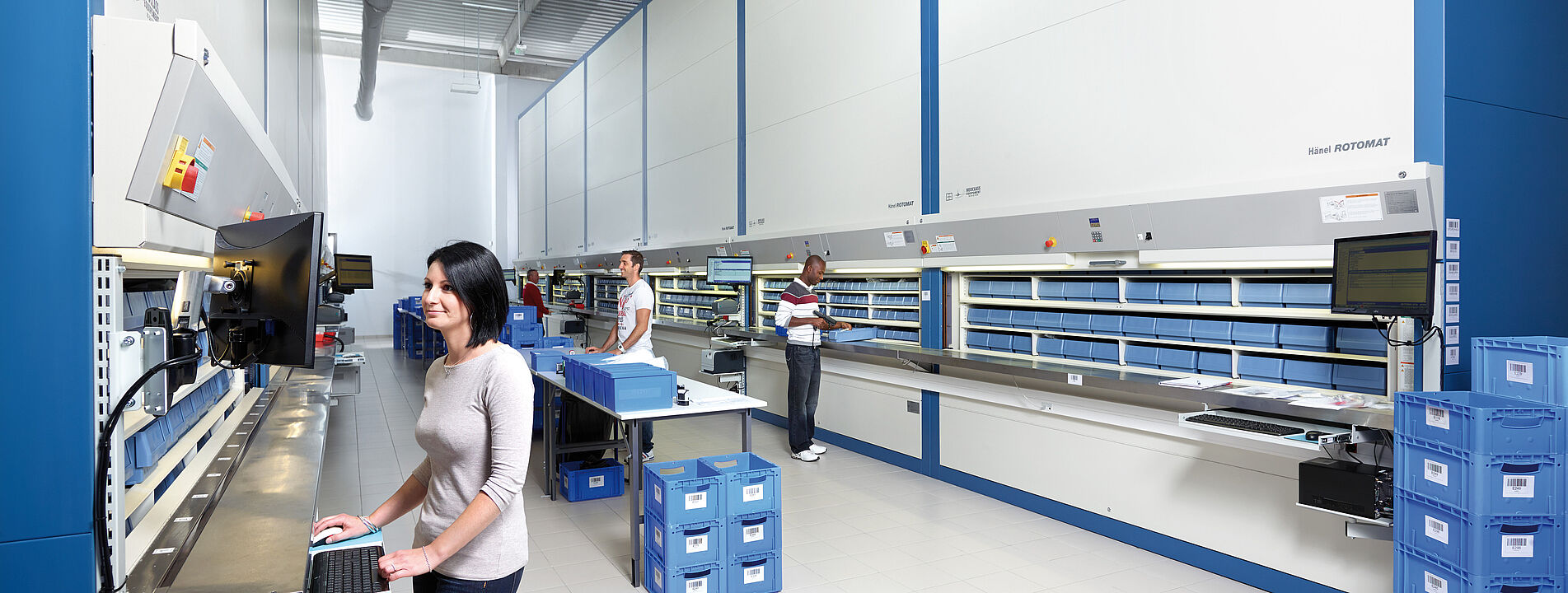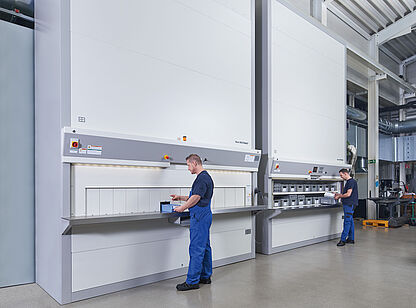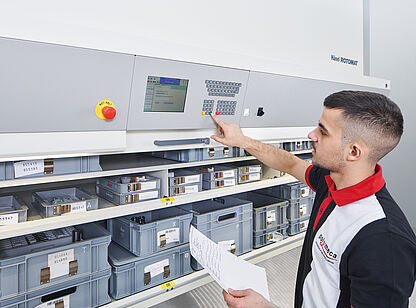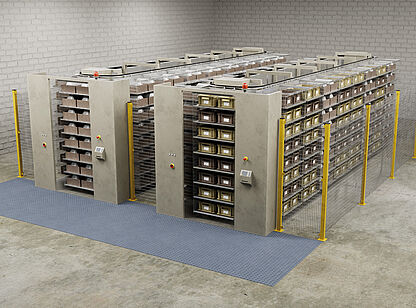Vertical Carousels vs. Horizontal Carousels
Choosing an industrial carousel for your warehouse storage needs requires multiple considerations. The goal of these considerations is to efficiently use space to increase safety and productivity. The benefits of vertical carousels and horizontal carousels can provide optimized storage solutions.
What Are Industrial Carousels?
The standard rack shelving systems used in many warehouses and storage facilities are lacking. Although simple and inexpensive, standard shelves are also less efficient, less safe, and less useful. Industrial carousels provide some of the best options when it comes to optimizing storage.
An industrial carousel is a set of moving shelves. These shelves are on a track on which its contents can be delivered to the user by request. Instead of searching for an item, the item comes to you. In the most basic sense, carousels bring a convenience to storage locations that may feel like a luxury. However, the benefits of industrial carousels extend well beyond ease of use. They help users:
- Gain floor space
- Control inventory
- Increase productivity
- Enhance security
- Improve ergonomics
The investment in industrial carousels is often less expensive in the long run because of the benefits listed above.
Vertical Carousels
A carousel is a rotating storage device that moves much like a Ferris wheel in order to rotate stored products to be within a comfortable reach of the retrieving person. The vertical carousel rotates in a vertical, or up-and-down, direction.
Vertical carousels can be designed to have different heights of up to 32 feet, which takes advantage of ceiling height. However, they are shallower than horizontal carousels, so they can rotate.
One of the great features of vertical carousels is that they can be expanded vertically through the roof. In cases of limited square footage, storage space is increased by moving it up. Horizontal expansion doesn’t provide that convenience because expanding horizontally requires more real estate or cramped
workspaces. Because of their design, vertical carousels are often placed against a wall, which frees the rest of the room for other purposes or more storage.
Horizontal Carousels
While a horizontal carousel still involves moving shelves, the shelves move from side to side. This was originally inspired by the hanging clothes racks rotating in a dry cleaning business, but the shelves or racks on the carousel can be stacked. This storage option moves horizontally back-and-forth, and once again, the user doesn’t have to locate the sought item.
The major negative aspect of horizontal carousels is that they take up more space. You cannot expand them vertically, so you must invest in more real estate if you want more storage. This ends up costing much more than what you can get with vertical expansion.
The technology for both vertical and horizontal carousel storage has been around since the 1950s. They have both consistently proved to improve labor, increase efficiency, and safely store items.
How to Choose a Carousel Storage System
Choosing between a vertical or horizontal carousel storage system depends on multiple factors:
- Size of items being stored
- Space available
- Ergonomic goals
- Efficiency desired
Size and Type of Items Being Stored
The vertical carousel storage system does an excellent job of getting stored items to your fingertips at a comfortable height, but it does have some space constraints. Generally speaking, the items that can be stored vertically must fit into carriers that are wide, but they are also shorter and shallower than horizontal carriers.
The weight limit also varies based on the type and model of carousel you choose. Vertical carousels may have a lower weight capacity, but the variance can be great. For example, the Hänel Rotomat® vertical storage carousels vary from a maximum payload of 331 lbs to 1,653 lbs per shelf. Some horizontal carousels
can carry 2,000 lbs or more per carrier, but you will lose the benefits of the vertical configuration.
The second part of size planning is regarding the consistency of product sizing at the storage site. There is more height flexibility in horizontal units. Overall, the vertical carousel systems have a larger cubic capacity, but this is best for smaller, uniform products.
Common uses for vertical carousel storage include medical supplies and industrial mechanical supplies. Often, these items are stored in totes and can easily be grabbed by hand. Storing bulkier items may require a horizontal storage carousel to handle the height of the item stored.
Space Available
While one carousel storage system has the capacity of four standard racks, there are still space considerations. Vertical carousel systems can be built taller than horizontal carousel systems. In fact, some storage sites build-on externally in order to provide more vertical space with a smaller internal access point.
With low ceilings, a horizontal carousel may be a better solution. However, vertical carousels can expand through a roof without having to invest in additional real estate. No matter how you look at it, you are going to save space with a carousel system. In many cases, a vertical storage system takes greater advantage over vertical space when it is available.
Ergonomic Goals
The goal of having things brought straight to your fingertips is gone with horizontal carousels. That doesn’t mean that they don’t improve safety by keeping products stacked in an organized manner, but there are still shelves at high and low heights.
If you want to eliminate stooping and reaching, a vertical carousel is a better option. Not only does the automated vertical carousel bring things to an average working height, but it also provides workspace. This workspace can extend the length of the shelf, which means ample room for working or setting things down to select additional products.
Efficiency
Finally, the speed at which people can retrieve items from storage is very important depending on the industry. This all has to do with the design of the carousel system for your organization and the workspaces necessary to increase productivity. It stands to reason that the longer a carousel is, the longer it will take to retrieve a product. Some systems can also be adjusted for a quicker rotation of the carousel.
Carousels and ASRS system guide
Once you figure out whether a vertical or horizontal carousel is the right industrial carousel for your warehouse or storage facility, you have to consider the automated storage and retrieval system (ASRS). There are a variety of options that increase inventory control and ease the retrieval process.
1. Foot control: A foot pedal to control the movement of shelving either vertically or horizontally is sometimes seen in carousel systems. This is less common because of improved and inexpensive alternatives.
2. Keypad control: Keypads are not only used to restrict access to certain inventory, but they are also integrated computer systems that can provide immediate access to carriers for specific product picking.
3. Barcode scanner: When applicable, the barcode scanner is one of the most efficient ASRS controllers for inventory management. The user simply has to scan the code, and the ASRS retrieves the appropriate bin/carrier.
4. Computer control: Finally, a computer can also do the work of a keypad control or barcode scanner in a similar manner. This may be appropriate for larger systems with more complex inventory supplies, or it may provide additional access to information that cannot be efficiently delivered by alternative means.
When choosing an ASRS, decision-makers should consider the user safety, necessary restrictions, workplace accommodations, and productivity needs in order to choose the best ASRS for their carousel storage system.
Whether you are in the retail industry or healthcare, the accuracy, speed, and safety of inventory retrieval is crucial to success. Considering your ASRS options is crucial in making the right decision regarding your industrial carousel.
Comparing Vertical Carousels vs. Horizontal Carousels
For many situations, the vertical carousel will outperform the horizontal carousel. This is for many reasons, except for the fact that vertical carriers don’t offer a lot of flexibility in the size of storage space. The benefits of vertical carousels over horizontal carousels include:
- Opening about 80 percent of the floor space used by standard racks
- Maximizing more cubic capacity in a small amount of space
- Making the best use of unused vertical space
- Focusing on ergonomics and employee safety
- Opportunity for vertical expansion (through the roof)
- Increasing efficiency/labor reduction
- Less damaged product
- Less errors
As any business owner or manager can imagine, the direct benefits of vertical industrial carousels lead to many resultant benefits.
1. Employee satisfaction: Convenience and comfort in the work environment due to options taken by decision-makers makes employees feel valued.
2. Employee health: Working in a safe environment with lessened risk for injury, fewer sick days needed, and less fear of workplace dangers.
3. Customer satisfaction: Fewer inventory errors and increased productivity lead to better customer feedback and retention.
4. Profitability: The 3 p’s of business are people, product, and profitability. If you take care of your employees and your products, you will increase profits.
Automated storage options that keep your products from becoming damaged and your employees from hurting themselves are a no-brainer. They are an investment in the future of your company, and they pay for themselves when they are implemented correctly.
When you go to configure your horizontal or vertical carousel storage, ensure that you are maximizing the benefits of the storage for the space you have available in your warehouse or storage facility. Also, take into account the needs of the employees who will interact with the ASRS, so you can ensure optimized input options that correlate with increased productivity and efficiency.
Space is one of the scarcest products available when it comes to warehouses and storage facilities, but you can maximize your space by opting for the technology available in automated vertical and horizontal carousels. The benefits the company will reap are plentiful, and standard racks will never again suffice.





